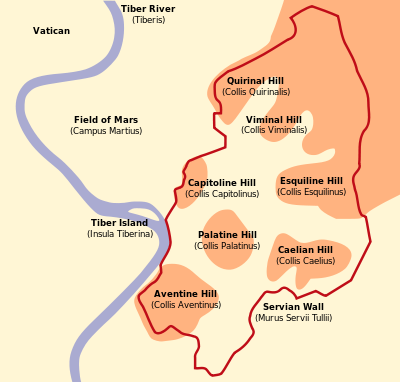Seven hills of Rome

The Seven Hills of Rome (Italian: Sette colli di Roma, Latin: Septem montes Romae) east of the river Tiber form the geographical heart of Rome, within the walls of the ancient city.
The seven hills are:
- Aventine Hill (Latin, Aventinus; Italian, Aventino)
- Caelian Hill (Caelius, Celio)
- Capitoline Hill (Capitolium, Campidoglio)
- Esquiline Hill (Esquilinus, Esquilino)
- Palatine Hill (Palatinus, Palatino)
- Quirinal Hill (Quirinalis, Quirinale)
- Viminal Hill (Viminalis, Viminale)
The original city was held by tradition to have been founded by Romulus on the Palatine Hill.
Tradition holds that the seven hills were first occupied by small settlements and not grouped or recognized as a city called Rome. The denizens of the seven hills began to participate in a series of religious games, which started to bond the groups. The city of Rome, thus, came into being as these separate settlements acted as a group, draining the marshy valleys between them and turning them into markets (fora in Latin). Later, in the early 4th century BC, the seven hills were protected through the Servian Walls.
Of the seven hills of current Rome, five (Aventine, Caelian, Esquiline, Quirinal, and Viminal hills) are populated with monuments, buildings, and parks. The Capitoline now hosts Rome's city hall, and the Palatine Hill belongs to the main archaeological area.
The Vatican Hill (Latin Collis Vaticanus) lying northwest of the Tiber, the Pincian Hill (Latin Mons Pincius), lying to the north, and the Janiculum Hill (Latin Ianiculum), lying to the west, are not counted among the traditional Seven Hills.
